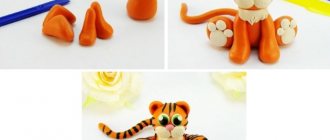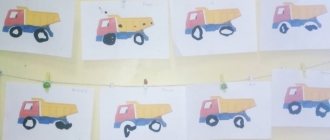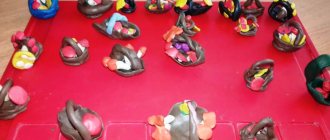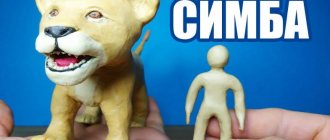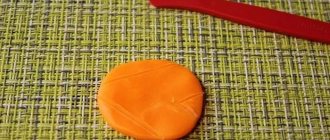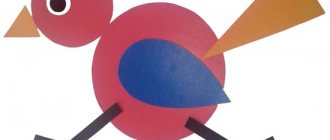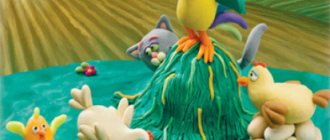Modeling lesson in the preparatory school group “Modeling decorative dishes”
Sections: Working with preschoolers
Subject:
Modeling of decorative dishes.
Program content:
- Continue to learn how to depict decorative dishes, conveying the features of shape and painting.
- Take a creative approach to doing the work and choose your own sculpting method.
- Decorate the finished product with an in-depth relief using stacks or moldings.
- Strengthen your neat sculpting skills.
Material and equipment:
- Rotary machines, stacks, wet sponges, stands, clay for each child.
- Illustrative material depicting decorative tableware, samples of decorative tableware for various purposes, a tape recording of calm music.
Preliminary work:
- Modeling dishes in different ways in classes and in independent activities, examining decorative dishes to analyze their shapes and decorations, talking about types of dishes in speech development classes.
PROGRESS OF THE CLASS
Children enter the art studio, say hello and go to the teacher.
Educator: Hello guys. Today we will continue our acquaintance with decorative tableware. Stand comfortably, close your eyes and imagine that we have been transported to the ancient world. Introduced? Now listen to my story. People have been making pottery since ancient times. At first they stored various products in it: vegetables, fruits, grains. But one day one pot became strong, light, sonorous, but most importantly, it did not get wet from water. This is how pottery entered the life of the first people. Gradually, when sculpting dishes, people began to change the shape of the products, making jugs with long narrow necks for water and wide massive vessels with strong handles for other products. Soon they began to select the most successful and beautiful products, and then they themselves began to decorate the dishes in different ways. For example, an ancient Greek vase is decorated with clay of different colors. Also, in what ways can you decorate dishes?
(Children's answers: with moldings, in-depth relief, painting)
That is, over time, dishes became a real decoration of the table, and then of a person’s home. Fancy, elegant vases and jugs of various shapes and sizes appeared, i.e. decorative dishes appeared. What does the word “decorative” mean?
(Children's answers)
Let's take a closer look at some of the products. Here in front of you are different types of dishes: vases, jugs, candy dishes, bowls. Do you like them? What exactly?
(Children's answers)
Guys, how do you think this vase was sculpted? And this sugar bowl? etc.
(I listen to the children’s answers, complement, add, repeat the sculpting methods again: pressing, picking, tape method.)
So, today we will also create decorative dishes, we will sculpt a wide variety of dishes using known methods. And of course we will decorate it either with molds or draw a pattern in a stack.
Sit down at the tables as you wish, sit nicely, keep your back straight. Think about what kind of dishes you would like to fashion, and what method you need to use for this.
(Children’s answers, advice, hint from the teacher)
Think carefully about how many parts you will divide the piece of clay into. We will dry the most successful works and take them away to decorate the group. Let's get to work, knead the clay well, divide it into parts.
(Children’s independent work, help, hint, reminder that before applying or drawing, it is necessary to carefully smooth the surface.)
After work, the teacher invites the children to wash their hands and examine the products made by the children, mark the most successful ones, and select them for the group.
– Now let’s close our eyes for a minute and try to remember the most interesting moments of the lesson, what did you like most?
(Children's answers)
14.03.2007
Share this page:
xn--i1abbnckbmcl9fb.xn--p1ai
Lesson summary for the senior group: artistic and aesthetic development modeling “Ceramicware”
Lesson summary for the senior group: artistic and aesthetic development modeling “Ceramicware”
Goal: tell children about the history of pottery, discuss its properties and use in the modern world; teach children to sculpt utensils from clay.
The story of the origin of pottery is told the day before so that children are aware of the concept of pottery.
Once upon a time, a thousand years ago, when primitive people lived, they found such a material as clay, taking it in their hands, they noticed that the clay was very soft and pliable, which means it can be used to create household items, dishes.
The first pots quickly chafed and leaked water, so later people began to fire the clay, which turned out to be very successful.
The clay pot was treated with great respect, it was cherished and revered. Why do you think? (because they eat from it, drink from it, cook food in it, etc.).
I have prepared items for you that are made of clay (mug, flower pot, whistle, etc.)
We looked and discussed.
Yesterday we talked about what pottery is like, and today I suggest you make a tea pair. What it is? That's right, it's a mug and saucer.
Before we begin, I suggest you stretch our hands and fingers, and finger exercises will help us with this.
Finger gymnastics “Spring Sun”
Little sun
I hold it in my palms (we show the little sun with our hands)
And the big sun
I see from the window (hands up, we wrap our arms around ourselves - “big sun”)
I take the little sun with my hands (we show the little sun)
And the big sun
High above the clouds (raise your arms above your head and look up)
Little sun
It shines in my palms (we show a little sun with our hands)
And the big sun
Shines on the whole planet! (raise your arms above your head and spread them to the sides)
We've stretched our hands, and now let's get to work. (Instructions for working with clay are discussed).
Instructions:
1) Divide the clay into two equal parts
2) There are jars of water to wet your fingers
3) A stack is required when decarving finished elements
4) Finished works are carefully displayed on a pedestal
Before doing the work, children examine ready-made samples of a tea pair made of clay, painted or not.
After completing the work, we discuss what worked. When the works are dry, they can be painted and set up for an exhibition.
Abstract of GCD Artistic creativity (modeling) TOPIC “Decorative plates for decorating a group”
TOPIC “Decorative plates for decorating a group”
Software tasks:
To develop the ability to creatively create an image based on a sense of form, selection and original combination of elements, color, in a unique composition.
Develop a sense of form, composition and the ability to create a pattern on any silhouette.
Create a desire to share joy, successful work with other people, a desire to give gifts to family and friends, using your skills in decorative activities
To develop children’s ability to sculpt decorative plates from a whole piece of plasticine using a plastic method.
Practice rolling a lump of plasticine between your palms, flattening it, and evenly pinching the edges
Introduce children to Khokhloma painting and its history. Fix to see and highlight the characteristic elements of the painting. Introduce the names of the painting elements: berries, flowers, curl, grass. Pay attention to the color scheme. Cultivate interest and love for folk art.
To cultivate respect for the traditions of Russian folk art.
Development in children of the prerequisites for a sense of patriotism, love, respect for the Motherland and people.
To cultivate respect for the traditions of Russian folk art.
Vocabulary work: exhibition, decor, exhibits, wood.
Materials: Khokhloma products, plasticine, stacks, surprise, music center.
Progress of the lesson.
Russian folk melody sounds
V. — Hello, guys, please say hello to our guests.
I suggest you play the game “Give a Compliment”, “Mood”
Today I invite you to the exhibition.
V. — Imagine that there are tickets on my palm. To take your ticket you need to touch my palm and say your name.
Children take turns coming up and saying their names.
V. - Does everyone have tickets? Go to the exhibition. This exhibition was created by the wizards - the artists of Golden Khokhloma.
All the leaves are like leaves,
Here, every one is golden.
Such beauty people
They call it... Khokhloma!
Music turns off
Our exhibition is completely unusual, unlike others - a unique exhibition. At our exhibition, objects can be picked up.
There are Khokhloma dishes on the table and shelves. I give the children objects to look at.
Q. - What do you think the products are made of? (children's answer)
These products are made of wood.
Q. - Why were they called gold? (children's answer)
They were called gold because the products have yellow leaves and a yellow background - similar to gold.
I’m telling you this while demonstrating a Khokhloma plate.
V. — Traditions in the manufacture and painting of products are passed down from generation to generation - to a son from his father, to a father from his grandfather. Bowls, bowls, and vases are first carved from wood and then prepared for painting. Cover with a thin layer of clay, dry the product, spread with oil and dry again in the oven, cover with drying oil, then rub with aluminum powder (silver). When the painting is finished and dried, the artist coats the product with varnish, and the silver under the yellow film becomes very similar to gold. This is how wonderful golden cups, bowls, vases and many other utensils are born.
www.prodlenka.org
Purpose of modeling in older preschool age
In older preschool age, through modeling dishes, children develop skills in conveying the shape of objects and their characteristics, the general structure of objects and their individual parts, and identifying important elements.
Based on this goal, the objectives of modeling classes for older preschoolers are:
Finished works on a similar topic
Course work Development of creativity in children of senior preschool age in modeling dishes 400 ₽ Abstract Development of creativity in children of senior preschool age in modeling dishes 280 ₽ Test paper Development of creativity in children of senior preschool age in modeling dishes 200 ₽
Receive completed work or specialist advice on your educational project Find out the cost
- Formation of the foundations of aesthetic perception of the surrounding world;
- Development of observation skills;
- Development of sensory standards: shape and size of objects, their similar and distinctive features, spatial position;
- Development of imagination;
- Development of intelligence;
- Activation of the child's creative thought.
Thus, modeling dishes in older preschool age contributes to the creative development of the child and the formation of the foundations of his independent activity.
Abstract of the GCD “Artistic Creativity” TOPIC “Decorative plates for decorating a group”
| Program objectives: To develop the ability to creatively create an image based on a sense of form, selection and original combination of elements, color, in a unique composition. Develop a sense of form, composition and the ability to create a pattern on any silhouette. To form a desire to share joy, successful work with other people, the desire to give a gift to family and friends, using one’s skills in decorative activities. To form children’s ability to sculpt decorative plates from a whole piece of plasticine using a plastic method. Practice rolling a lump of plasticine between your palms, flattening it, and evenly pinching the edges Download the full version of the abstract Introduce children to Khokhloma painting and its history. Fix to see and highlight the characteristic elements of the painting. Introduce the names of the painting elements: berries, flowers, curl, grass. Pay attention to the color scheme. Cultivate interest and love for folk art. To cultivate respect for the traditions of Russian folk art. Development in children of the prerequisites for a sense of patriotism, love, respect for the Motherland and people. To cultivate respect for the traditions of Russian folk art. Vocabulary work: exhibition, decor, exhibits, wood. Materials: Khokhloma products, plasticine, stacks, surprise, music center. Progress of the lesson. A Russian folk melody is playing. V. - Hello, guys, please say hello to our guests. I invite you to play the game “Give a Compliment”, “Mood”. Today I invite you to the exhibition. V. — Imagine that there are tickets on my palm. To take your ticket you need to touch my palm and say your name. Children take turns coming up and saying their names. V. - Does everyone have tickets? Come to the exhibition. This exhibition was created by the wizards - the artists of Golden Khokhloma. All the leaves are like leaves, but here, every one is golden. People call such beauty... Khokhloma! The music turns off Our exhibition is completely unusual, not like others - a unique exhibition. At our exhibition, objects can be picked up. There are Khokhloma dishes on the table and shelves. I give the children objects to look at. Q. - What do you think the products are made of? (children's answer) These products are made of wood. Q. - Why were they called gold? (children's answer) They were called gold because the products have yellow leaves and a yellow background - similar to gold. I’m telling you this while demonstrating a Khokhloma plate. V. — Traditions in the manufacture and painting of products are passed down from generation to generation - to a son from his father, to a father from his grandfather. Bowls, bowls, and vases are first carved from wood and then prepared for painting. Cover with a thin layer of clay, dry the product, spread with oil and dry again in the oven, cover with drying oil, then rub with aluminum powder (silver). When the painting is finished and dried, the artist coats the product with varnish, and the silver under the yellow film becomes very similar to gold. This is how wonderful golden cups, bowls, vases and many other utensils are born. V. - Guys, let's put the exhibits in place, I invite you to the second hall. There are empty shelves there. I pay attention to the children's reactions. V. - This is an unusual hall. You see that the shelves here are empty. This is a hall for beginners, young masters. Do you know how to sculpt from plasticine? Do you know what patterns are? Can you organize your own exhibition? D. - Yes, we will be able to organize our own exhibition. . Guys! Please look at the plates on the tables, are they as beautiful as this one? Why? That's right, they're not finished. And you young masters will have to work hard to complete the work so that the plates can be placed at the exhibition. Do you agree? Please sit down at the tables. Finger gymnastics Here are all my fingers, turn them the way you want: (Look at the open palms and twirl them) And this way, and this way, they won’t be offended in any way. (Rub our hands together) One, two, three, four, five, (Clap our hands) They can’t sit again. (Shaking the brushes) Knocked, (Knocked on the table) Twirled (Circular rotations with the brush) We wanted to sculpt. (Rub with hands) They will work a little, (Actively moving fingers) We will let them rest. (Put palms together) I give instructions to the children: It’s time for us to decorate the exhibition; whoever has finished, put the beautiful plates on the shelves. Now in the hall of young masters there are also products and are pleasing to the eye. You like? Our exhibition is ready. Which one of you will be a guide and tell you about your product: what color is the plate, what patterns are drawn? 1 – 2 children talk about their work. We had a wonderful exhibition. Did you like it? Do you want to further improve your skills? As a souvenir, I want to give a workbook “Khokhloma Painting” and a coloring book. This will allow you to become real Khokhloma masters. doshkolnik.ru |
modeling of decorative dishes
Modeling lesson in the preparatory school group “Modeling decorative dishes”
Program content:
Continue to learn how to depict decorative dishes, conveying the features of shape and painting.
Take a creative approach to doing the work and choose your own sculpting method.
Decorate the finished product with an in-depth relief using stacks or moldings.
Strengthen your neat sculpting skills.
Material and equipment:
Rotary machines, stacks, wet sponges, stands, clay for each child.
Illustrative material depicting decorative tableware, samples of decorative tableware for various purposes, a tape recording of calm music.
Preliminary work:
Modeling dishes in different ways in classes and in independent activities, examining decorative dishes to analyze their shapes and decorations, talking about types of dishes in speech development classes.
PROGRESS OF THE CLASS
Children enter the art studio, say hello and go to the teacher.
Educator: Hello guys. Today we will continue our acquaintance with decorative tableware. Stand comfortably, close your eyes and imagine that we have been transported to the ancient world. Introduced? Now listen to my story. People have been making pottery since ancient times. At first they stored various products in it: vegetables, fruits, grains. But one day one pot became strong, light, sonorous, but most importantly, it did not get wet from water. This is how pottery entered the life of the first people. Gradually, when sculpting dishes, people began to change the shape of the products, making jugs with long narrow necks for water and wide massive vessels with strong handles for other products. Soon they began to select the most successful and beautiful products, and then they themselves began to decorate the dishes in different ways. For example, an ancient Greek vase is decorated with clay of different colors. Also, in what ways can you decorate dishes?
(Children's answers: with moldings, in-depth relief, painting)
sundekor.ru
TEACHING PRESCHOOL CHILDREN IN MODELING DISHES
MOLDING.
According to the artist and animal painter V.A. Vatagina, modeling, is a sculptural and plastic way of reflecting reality from soft materials (clay, wax, plasticine) by increasing or removing plastic mass.
The uniqueness of modeling as one of the types of productive activity lies in the three-dimensional method of depiction. Preschoolers can master the techniques of working with soft plastic materials that can be easily manipulated by the hand.
Modeling, like other types of visual activities, primarily fulfills educational tasks, satisfying the cognitive and creative needs of the child. The main expressive means of modeling is plasticity, the transmission of shape and movement.
The plasticity of the material and the volume of the depicted form allow a preschooler to master some technical techniques in modeling faster than in drawing. For example, conveying movement in a drawing is a complex task that requires a long learning curve. Modeling makes the solution to this problem easier. The child first sculpts the object in a static position, and then bends its parts in accordance with the design. The transfer of spatial relationships of objects in modeling is also simplified - objects, as in real life, are placed one after another, closer and further from the center of the composition. Issues of perspective in modeling are simply removed. The main means of creating an image in modeling is the transfer of a three-dimensional form.
By doing sculpting, a child gets acquainted with the three-dimensional shape of an object, the relationship of its parts, he develops the skills of working with two hands, coordination of movements, the small muscles of the fingers very actively develop, and this contributes to the development of thinking, eye, and spatial thinking. It is difficult to overestimate the importance of modeling for the development of a child. Modeling is the most dynamic, cheerful children's creativity.
Dynamics of increasing complexity
of tasks in learning to sculpt dishes in preschool age.
Modeling, as a type of visual activity for children, is closest to pottery. Let us dwell in more detail on the tasks of teaching tableware modeling in preschool age.
In her book, N. B. Khalezova (teacher, specialist in the development of artistic creativity in preschool children), describes the following technical techniques in teaching tableware modeling in different age groups:
First junior group
Before teaching children to depict an object, they must be taught to examine it, examine it, and be able to identify its main properties. Image training should be done through showing a real object or toy.
When considering an object, the following goals are set: to make the process of perceiving the object deliberate; to arouse in children orienting activity, attention, and interest in the subject being examined; teach to identify the main parts of the subject; establish a connection between what is perceived and an existing skill.
For younger preschool age, it is typical to create three-dimensional shapes - a cylinder, a ball, a disk, therefore, training in formative movements should be carried out through modeling the simplest objects: a cylindrical shape - a stick, a sausage; round - ball, apple, pancake, flatbread, etc.
In pottery sculpting, children are taught to depict disc-shaped objects by flattening a spherical shape between their palms. So, flattening the rolled out lump, the children make a saucer. In a rolled ball, making a depression in the middle with a finger, children make a cup.
Examination of an object (vase) should be carried out according to the methodology: first, a holistic perception of the object, and then examination of its component parts (legs, plates).
The leading method of teaching formative movements is demonstration, accompanied by a simple, precise explanation of the actions. A figurative word enhances the effectiveness of the demonstration and creates the opportunity to later move on to verbal instructions. The word as a method of guidance is also necessarily used when organizing the perception of an object: the word helps to fix children’s attention on those qualities that they must later depict.
Second junior group.
Children of the second younger group are more prepared for modeling classes. Some of them are familiar with the material, they know that clay can be sculpted, and they know the simplest methods of producing a cylinder, ball, or disk. Completed items begin to evoke a feeling of joy and satisfaction in children. However, they still do not have a clear connection between the movements of the hand and the resulting form; there is no stability in the design. In this regard, in the second junior group, existing visual skills are mainly consolidated.
The tasks of teaching modeling are solved in classes according to the instructions and according to the children’s plans. These tasks include: encouraging children to sculpt, evoking aesthetic feelings in them, and also teaching them to orient themselves in the shape of objects, their size and quantity while sculpting.
Children make dishes in the same way as in the first junior group. . This way children can make a tea pair. Then they learn to sculpt with a complication: the edges of the saucer (plate) are raised using the pinching method.
But, for example, when sculpting a cup, children, having made a depression in the ball, flatten the walls of the cup with their fingers, giving it a certain shape. Children are introduced to the use of expressive means. Using specially prepared sticks - signets, which in cross-section can have different shapes: circle, square. decorate the surface of the dishes.
Education of children in the second junior group should include the development of children's independence. Therefore, in cases where children are familiar with modeling techniques, they are not shown them again.
Middle group.
The main task of teaching modeling remains the task of cultivating a sustainable interest in plastic activity, its process, the quality of the image of the object and the result. Children are required to be able to express their impressions in a plastic image so that it can be easily recognized and expressive.
The goal of this year of study is to develop in children the ability to independently find ways to depict objects, creatively applying the acquired knowledge and skills. Working on technical sculpting skills is of primary importance. Children consolidate and refine techniques learned in previous kindergarten groups and master new ones. Considerable attention is paid to working on the arbitrariness and quality of movement. To obtain different shapes of objects, various forces of pressing, pressing, rolling, flattening, and pulling are required.
The main content of the assignments is substantive in nature, but children are also taught plot modeling. They complete the first tasks together with the teacher. Later, the children independently perform small episodes based on a fairy tale, poem, or story. After reading K. Chukovsky’s work “Fedorino’s Grief,” the teacher suggests talking about it in modeling. Everyone decides together what plot to depict: how the dishes ran away from Fedora or how she came back. All the children make dishes (whoever wants what), and the teacher - Fyodor. At the end of the lesson, a composition is compiled. Such joint creativity, joint searches teach you to create an expressive image, help to evoke an emotional mood and interest in sculpting.
In the middle group, work continues to develop children's aesthetic perception, the ability to see and feel the beauty of the shapes of surrounding objects, their proportions. Children learn to evaluate created works and express their elementary judgments. When depicting any object, you can be given the task of decorating this object with a pattern. Thus, children decorate molded dishes (cups, saucers) using a stack, a set of signets (patterned relief drawing) or create a pattern from small pieces of clay (patterned).
The first modeling lessons in the middle group are aimed at consolidating and restoring in the children’s memory the techniques that were taught last year, complicating and clarifying such technical operations as rolling, connecting, rolling, pinching.
When sculpting dishes, children remember such methods as creating hollow shapes by pressing a finger into a spherical or cylindrical shape (cup, bowl, glass, mug), bending the edges of a flattened shape (plates, saucer, tray). So, using shapes already known to them, children can make a fruit vase, which consists of two parts: a disk - a plate and a cylinder - a leg.
The child completes details such as handles, decorations on the edges of mugs and saucers by attaching and applying individual parts to the overall shape. Having sculpted the dishes, decorate them well, making various patterns using stacks.
Senior group.
A child’s experience in perceiving the general shape of objects and its structure is greater than that of children of the fifth year of life, but they cannot always accurately determine its features and proportions. The child becomes more independent in analyzing objects and choosing sculpting methods; his products become more and more diverse. Items made by children in the senior group testify to their creative abilities.
General modeling tasks for children of the sixth year of life: develop observation and aesthetic perception, clarify the idea of the shape of objects, their differences and similarities, position in space, characteristic features; develop children's imagination, independence in choosing a topic and selecting methods of depiction, initiative, and ingenuity.
All these tasks are specified in such a way as to lead children to create an image that is expressive both in form and content. Modeling of individual objects should teach children to convey the basic character of the form, structure of the object, and the proportions of the most important details.
Children 5-6 years old create simple plots, sculpt objects and decorative objects.
The content of tableware modeling classes in the older group becomes more and more complex. Taking into account the emerging ability of children to compare their work with the subject of the image, it is possible to teach modeling from life, especially when the main task is to master a new form. If problems of a creative nature are being solved, then it is better to offer modeling based on the idea (after observations).
Modeling dishes from life. The purpose of these classes is to: expand children's understanding of shape and proportions; teach them to depict a form, remembering and independently applying familiar sculpting methods; teach to compare your sculpture with nature throughout the lesson, and during the analysis of works, compare not only your own work with nature, but also the work of your comrades, i.e. cultivate activity and independent thinking.
Modeling dishes according to presentation. The main goal of these classes is to develop independence in solving an image perceived earlier, and to develop creative activity in the use of sculpting methods. The children are taught to think about the content of the sculpt in advance. To do this, before observation, they are warned that they will sculpt the piece of utensils that they are examining or about which they are read or told. The target setting makes it possible to interest the children and direct their attention to a deeper perception of the subject.
In the older group, children make dishes in ways not only already learned in the middle group, but also new ones. For example, they sculpt the handle of a mug differently, making it from a bent column, and treat the surface more carefully. They are also shown a new way of sculpting a mug - the ribbon method, by connecting a disk - the bottom and a ribbon-shaped wall - a flattened cylinder. The children learn to divide a lump of clay, measure the parts, and apply one part to another.
Modeling dishes can be decorative; in this case, children are asked to decorate the surface of the vessel with a high or deep relief.
Preparatory group.
Children in the preparatory group have accumulated a large stock of visual images that can form the basis of an image and create quite expressive images in modeling. Children of the seventh year of life, compared to five-year-old children, are capable of prolonged viewing and observation; they more fully remember and perceive the shape, structure of objects, their proportions and details.
In connection with the increased opportunities for the development of children's visual skills, the following tasks are set in teaching modeling: to develop visual and muscular perception of the shape of objects; teach children to use various expressive means to create an image; teach various visual and technical techniques; develop creative initiative in selecting themes for modeling. In the preparatory group, modeling is of a subject, plot and decorative nature. Children depict various objects either from life or from an idea - after observation and examination. You can invite the children to create a general composition by combining all the items on some kind of stand in the form of a tray. Each child can create a small composition. Children can sculpt such a composition based on their imagination, independently selecting objects to depict and methods of sculpting.
Children in the preparatory group are freer in choosing objects to sculpt; they more boldly take on sculpting objects that they have not previously depicted. While sculpting from life, the guys must compare their work with the object that stands in front of them; in addition, they should have a need to see the object from all sides while sculpting.
In the older group, children have already sculpted dishes; in the preparatory group they are shown new ways of depicting, for example, the method of sculpting from a rope, the ends of which are glued to each other, forming a ring. Clay rings are laid one on top of the other and tightly connected to each other (the joints on the inside and outside are covered). Using this method you can make a mug, bowl, salt shaker, or flower vase. Children aged 6 years are shown another method of sculpting vessels - selecting clay in a stack from a spherical or cylindrical shape. The difficult thing with this method is removing the clay by stacking: you need to make sure that the walls of the vessel are not very thin. At the same time, the children learn how to process the product by smoothing the surface with water. This is necessary for the subsequent design of the vessel - applying relief or painting.
Just as in previous groups, children in the preparatory group observe and examine objects before sculpting. It is important that they learn to notice what is characteristic, interesting, and beautiful in objects. During observations, children are asked questions that direct their attention to those characteristic features that will help make the image expressive.
You can take children to an exhibition or a museum of applied art, which usually makes a strong impression on them. It is good to show the children decorative plates with content accessible to them, and ceramic dishes. While examining the dishes, the teacher asks the children what the vessel is for, what shape it is, how it is decorated, and how it can be made from clay. If children know how to sculpt, they will quickly answer questions, and the teacher can talk about pottery workshops and how master artists sculpt dishes on special machines. During classes, the teacher shows some image techniques. For children 6-7 years old, there is no need to demonstrate them every time: more often the teacher uses an explanation at the beginning of classes, talks with the children, clarifying the basic means of expression, and shows only what the children do not know how to do, for example, partially demonstrating a new way of sculpting vessels from rings or by removing the clay in a stack from a spherical shape. Thus, children in the pre-school group are shown only unfamiliar techniques.
Conclusion: Successful teaching of modeling largely depends on how children are guided during the lesson. The main task is to direct children to the correct independent solution of the plan without disrupting the overall progress of the work.
Used Books.
- Modeling in kindergarten: A manual for kindergarten teachers. / Khalezova, N.B.; Kurochkina, N.A.; Pantyukhina, G.V. - M.: Education, - 1978. - 144 p.
- Theory and methodology of visual activity in kindergarten: Textbook for pedagogical students. Institute / V.B. Kosminskaya, E.I. Vasilyeva, N.B. Khalezova, etc. –– M.: Education, 1977. – 253 p.
